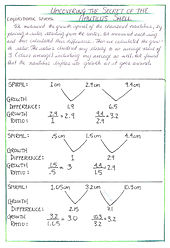Talk:Waldorf education/Science
The following compares the various descriptions of the role of science in Waldorf schools that appeared the version of the first week of March, 2015, with any possible future version.
Older version
[edit]The version of early March 2015 had material on science in several sections. These follow here.
Science instruction
[edit]In 1999, The Chicago Tribune reported that the 7th grade class of the first Waldorf-inspired school in California achieved the state’s top test scores in reading, language arts and mathematics but that there was a federal lawsuit underway that could close it[1] (the lawsuit was later dismissed on its merits). The paper reported that the school faced allegations from People for Legal and Nonsectarian Schools (PLANS) and the executive director of the National Center for Science Education (NCSE) that it was violating the establishment clause of the US Constitution and that it was also teaching pseudoscience. Eugenie Scott, executive director of the NCSE, told the Chicago Tribune that “Waldorf science relies upon a religious—certainly a cultish—philosophy" and described Rudolf Steiner, the founder of the first Waldorf school, as a "nut case from the 19th Century". This view was disputed by Arthur Zajonc, a physics professor at Amherst College, who had previously co-founded an independent Waldorf high school. He said that Waldorf schools teach “sound science” but do not "teach that a particular viewpoint by a particular scientist is 'the truth'. We present it as a hypothesis that they should be critical of." Zajonc added that many Waldorf graduates "have gone on to major in science at Harvard, MIT and other prestigious universities".

A few years after this news report, another Waldorf-inspired charter school commissioned a study on grade school science education. The study compared a group of American Waldorf school students to American public school students on three different test variables.[2] Two tests measured verbal and non-verbal logical reasoning and the third was an international TIMMS test. The TIMMS test covered scientific understanding of magnetism. The researchers found that Waldorf school students scored higher than both the public school students and the national average on the TIMMS test while scoring the same as the public school students on the logical reasoning tests.[2] However when the logical reasoning tests measured students' understanding of part-to-whole relations, the Waldorf students also outperformed the public school students.[2] The authors of the study noted the Waldorf students' enthusiasm for science, but viewed the science curriculum as “somewhat old-fashioned and out of date, as well as including some doubtful scientific material.”[2] Educational researchers Phillip and Glenys Woods, who reviewed this study, criticized the authors' implication of an “unresolved conflict”: that it is possible for supposedly inaccurate science to lead to demonstrably better scientific understanding.[3]
In early 2015, Waldorf schools throughout the United States made nationwide news as a result of having some of the highest rates of vaccine exemptions of any schools in their respective states.[4][5][6][7]
Studies
[edit]For example, the 2009 PISA study found that, compared to state school students, European Waldorf students are significantly more capable in the sciences.[8] A smaller 2003 study of science education in American Waldorf schools found the scientific reasoning of Waldorf school pupils to be superior to that of non-Waldorf students, with the greatest gains in the later years of schooling.[9]: 29
United Kingdom
[edit]There have been criticisms of the science education in the Steiner Academies. In September 2012, an editorial in the Times Educational Supplement reported that the British Humanist Association had issued a press release raising concerns about a curriculum reference book being used for state-funded Steiner schools. The editorial reported that the curriculum book “says the model of the heart as a pump is unable to explain 'the sensitivity of the heart to emotions' and promotes homeopathy". The book was also quoted as saying "Darwinism is 'rooted in reductionist thinking and Victorian ethics'". Richy Thompson, education officer of the British Humanist Association stated, "how can pupils receive a vigorous science education under these circumstances? It is gravely concerning that these schools provide alternative medicines such as homeopathy, thus legitimising belief in cures which do not work." Edzard Ernst, emeritus professor of complementary medicine, was quoted as saying that Waldorf schools "seem to have an anti-science agenda which is detrimental to progress... the [UK] government makes a grave mistake allowing pseudoscience and anti-science in our education."[10] A United Kingdom Department for Education spokeswoman responded by saying "no state school is allowed to teach homeopathy as scientific fact. We have rigorous criteria for approving free schools. Applicants must demonstrate that they will provide a broad and balanced curriculum."
Proposed new version (workspace)
[edit]- ^ Haynes, Dion (20 September 1999). "Waldorf School Critics Wary of Religious Aspect". Chicago Tribune.
- ^ a b c d Østergaard, Edvin; Dahlin, Bo; Hugo, Aksel (1 September 2008). "Doing phenomenology in science education: a research review". Studies in Science Education. 44 (2): 93–121. doi:10.1080/03057260802264081.
- ^ Woods, Philip A.; Glenys J. Woods (2008). Alternative Education for the 21st Century Philosophies, Approaches, Visions. Palgrave. p. 219. ISBN 978-0-230-60276-2.
There are unresolved conflicts here, principally between a science education based on "inaccurate science" that leads to better scientific understanding.
- ^ Smith, Morgan (5 February 2015). "See Vaccination Exemptions in Texas by School District". Texas Tribune. Retrieved 5 February 2015.
- ^ Dover, Haley (5 February 2015). "Vermont schools report low vaccination rates". Burlington Free Press. Retrieved 5 February 2015.
- ^ Yee, Greg (24 January 2015). "Waldorf school in Belmont Heights reports low vaccination rate". Long Beach Press-Telegram. Retrieved 5 February 2015.
- ^ "Vaccine exemptions exceed 10% at dozens of Seattle-area schools". Seattle Times. 4 February 2015. Retrieved 5 February 2015.
- ^ Cite error: The named reference
Welt2012was invoked but never defined (see the help page). - ^ Cite error: The named reference
Woodswas invoked but never defined (see the help page). - ^ Barker, Irena (17 September 2012). "Homeopathy? Sorry, we're just not swallowing it". TES. Retrieved December 2012.
{{cite web}}: Check date values in:|accessdate=(help)
